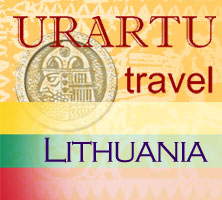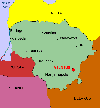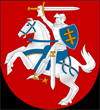About Lithuania
General Information -- Geography -- Climate -- Religion -- Language -- Population and Ethnic Composition-- Government -- Administrative Division -- Time Zone -- Currency Exchange and Credit Cards -- Capital City -- Official Holidays -- Airports and Public Transportation -- Traditional Cuisine -- Brief History
General Information
Lithuania, officially the Republic of Lithuania, is a country in Northeastern Europe. The largest of the three Baltic States situated along the Baltic Sea, it shares borders with Latvia to the north, Belarus to the southeast, Poland to the south, and the Russian exclave of the Kaliningrad Oblast to the southwest. Lithuania has been a member state of the European Union since May 1, 2004.
Lithuania is a treasure trove of unspoiled natural beauty, magical coastline and cobbled baroque cities.
Geography
Lithuania is situated in northern Europe and is the largest and most populous of the Baltic states (65,200 sq. km), it has around 99 kilometers of sandy coastline, of which only about 38 kilometers faces the open Baltic Sea. Lithuania's major warm-water port of Klaipėda lies at the narrow mouth of Curonian Lagoon, a shallow lagoon extending south to Kaliningrad. The main river, the Nemunas, and some of its tributaries carry international shipping vessels.
The Lithuanian landscape is glacially flat, except for morainic hills in the western uplands and eastern highlands that are no higher than 300 meters, with the highest point being found at Juozapinės at 292 meters. The terrain features numerous lakes, Lake Vištytis for example, swamps, and a mixed forest zone covers 30% of the country. According to some geographers, Lithuania's capital, Vilnius, lies a few kilometers south of the geographical centre of Europe.
Climate
The climate lies between maritime and continental, with wet, moderate winters and summers.
Religion
The historically predominant religion is Roman Catholicism (79%). The diverse Protestant community (1.9 % of the total population) is much smaller than the Roman Catholic Church; Protestants are scattered all over the northern and western parts of Lithuania. Lithuania was historically positioned in between the two German-controlled states of Livonia to the north and the Protestant formerly monastic, Teutonic State of Prussia to its south. From those two regions in 16th century Lutheran Protestantism started to spread into the country. After 1945 Lutheranism in the country has declined. Baptist and Calvinist and other Protestant churches, have attempted to convert members into their faiths since 1990.
The country also has minority communities of Eastern Orthodoxy (mainly among the Russian minority), to which about 4.9 % of the total population belong, as well as of Judaism, Islam and Karaism (an ancient offshoot of Judaism represented by a long-standing community in Trakai), which together make up for another 1.6 % of the population.
Language
Lithuanian is the official language of Lithuania, spoken by about 4 million native speakers. Because of Soviet occupation, most Lithuanians are bilingual in Russian. According to the Eurostat poll about 80% of the Lithuanians can hold a conversation in Russian and almost all are familiar with the most general phrases and expressions. Nowadays, most Lithuanian schools teach English as a first foreign language, but students may also study German, or, in some schools, French. Schools where Russian and Polish are the primary languages of education exist in the areas populated by these minorities.
Population and Ethnic Composition
85% of the Lithuanian population of 3.6 million are ethnic Lithuanians who speak the Lithuanian language (one of two surviving members of the Baltic language group), which is the official language of the state. Several sizable minorities exist, such as Poles (6.7%), Russians (6%), and Belarusians (1.1%).
Poles are the largest minority, concentrated in southeast Lithuania (the Vilnius region). Russians are the second largest minority, concentrated mostly in two cities; they constitute sizeable minorities in Vilnius (13%) and Klaipėda (20%) and a slim majority in the town of Visaginas (55%)
Government
The Lithuanian head of state is the President, elected directly for a five-year term, maximum two terms consecutively. The post of President is largely ceremonial with functions of overseeing foreign affairs and national security policy. The President is also the commander-in-chief. The President, on the approval of the Seimas, also appoints the prime minister and on the latter's nomination, appoints the rest of the cabinet, as well as a number of other top civil servants and the judges for all courts. Judges of the Constitutional Court, who serve for nine year terms, are appointed by the President (three judges), the Chairman of the Seimas (three judges) and the chairman of the Supreme Court (three judges).
The unicameral Lithuanian parliament, the Seimas, has 141 members who are elected to four-year terms. 71 of the members of this legislative body are elected in single constituencies, and the other 70 are elected in a nationwide vote by proportional representation. A party must receive at least 5% of the national vote to be represented in the Seimas.
Administrative Division
The current administrative division was established in 1994 and modified in 2000 to meet the requirements of European Union. Lithuania now has a three-step administrative division: Lithuania is divided into 10 counties (apskritys) that are later subdivided into 60 municipalities (savivaldybės) which consist of over 500 elderates (seniūnijos).
Time Zone
Lithuania is in the Eastern European Time Zone. Eastern European Standard Time (EET) is 2 hours ahead of Greenwich Mean Time (GMT+2).
Like most states in Europe, Summer (Daylight-Saving) Time is observed in Lithuania, where the time is shifted forward by 1 hour 3 hours ahead of Greenwich Mean Time (GMT+3).
After the summer months the time in Lithuania is shifted back by 1 hour to Eastern European Time (EET) or (GMT+2)
Currency Exchange and Credit Cards
Lithiania’s currency is the litas (Lt). The litas comes in 10, 20, 50, 100, 200 and 5000Lt notes and one, two and five litas coins. One litas is 100 cents (ct).
Lithuania’s main cities and towns have banks and exchange offices that convert currency. Major bank chains have ATNs, transfer money facilities, cash travelers cheques and give cash advance. The Euro is accepted in hotels as legal tender, some prices are only quoted in euros.
Capital City
Vilnius is the capital and largest city of Lithuania, with a population of 553,904 as of December 2005. It is the capital of the Vilnius city municipality and of the Vilnius district municipality. It is also the county seat of Vilnius County.
Some historians identify the city with Voruta, a legendary capital of Mindaugas crowned in 1253 as King of Lithuania. Initially a Baltic settlement, later Vilnius was also inhabitated by Slavs and, from at least the 11th century, by Jews. The city was first mentioned in written sources in 1323, after a wooden hillfort had been built by Gediminas, Grand Duke of Lithuania. In 1387, it was granted municipal rights by Jogaila, one of Gediminas' successors.
The Unesco world heritage-listed Old Town offers candle-lit bars, cobbled streets and a skyline of baroque church steeples to inspire and bewitch.
Official Holidays
- 1 January – New Year’s Day<
- 16 February - Independence Day (anniversary of 1918 independence declaration)
- 11 March - the Restoration of Lithuania’s Independence
- April – Good Friday and Easter Monday
- 1 May – Labour Day
- 6 July – Commemoration of Grand Duke Mindaugas’ coronation
- 1 November – All Saints’ Day
- 25 December – Christmas Day
- 26 December – Boxing Day
Airports and Public Transportation
Vilnius Airport is served by direct flights from Amsterdam, Berlin, Brussels, Copenhagen, Frankfurt, Helsinki, Kiev, London, Moscow, Prague, Riga, Stockholm, Tallinn and Warsaw.
Vilnius Bus Station is served by international buses to Amsterdam, Kaliningrad, London, Minsk, Prague, Riga, Tallinn, Vienna and Moscow.
Vilnius Train Station is served by international trains to/from Moscow, St Petersburg and Kaliningrad.
Trolleybuses and buses start running at 4am in Vilnius and finish at midnight. A single ticket for a journey on either costs 0.80 Lt from a press kiosk (or 1Lt from the driver). Microbuses zoom around most cities and offer a quicker and slightly more expensive transportation.
Traditional Cuisine
Lithuanian cuisine consists mostly of the traditional Lithuanian dishes. Because of a rather common climate and agriculture, many similar staples are grown and consumed in all Eastern Europe, thus Lithuanian cuisine belongs to a big family of Eastern European cuisines. Nevertheless, it has its own peculiarities, which were formed during the country's difficult history and by many different influences.
Because of long common history with Poland, Lithuanians share many similar dishes and beverages. Thus they have their own versions of pierogi (koldūnai), pączki (spurgos), blini (blynai). German traditions also influenced Lithuanian cuisine during ages, while introducing a lot of pork and potato dishes, such as potato pudding kugelis, potato sausages vėdarai. The most exotic part of all the influences is Eastern (Karaite cuisine and other) influence, and such dishes as kibinai, čeburekai are popular in Lithuania.
Brief History
It’s the classic riches to rags story- Lithuania once had an empire stretching all the way from the Baltic to the Black sea. A powerful state from the 14th to the 16th centuries, Lithuania disappeared off the maps of Europe when it was colonized by Poland and Russia.
In 1940, Lithuania was forced to become part of the USSR. Within a year 4,000 Lithuanians were killed or deported. Up to 300,000 more people, mostly Jews, died in concentration camps, and Ghettos during the 1941-44 Nazi occupation. The USSR returned with a vengeance in 1945, and an estimated 200,000 people were murdered or deported to Siberia.
In the late 1980s Lithuania was the first soviet state to legalize non-communist parties, and on 11 March, 1990 the new majority party declared independence. Moscow responded by marching troops into Vilnius, killing 14 people.
The Soviets recognized Lithuanian independence on 6 September 1991, and the first ex-USSR republic was born.
Lithuania replaced the rouble with the litas in March 1993, joined NATO in April 2004 and was accepted as a full member of the EU on 1 May 2004. But Lithuanian’s ride into Europe has not been with controversy. In April 2004 the constitutional court ruled that President Rolandas Paksas violated the country’s constitution by arranging citizenship for Yuri Borisov, a businessman with alleged links to organized crime. The President was impeached and ousted days later.



